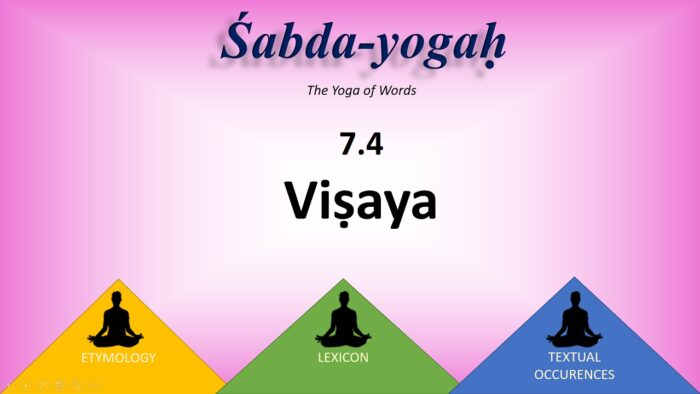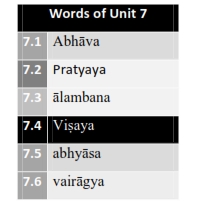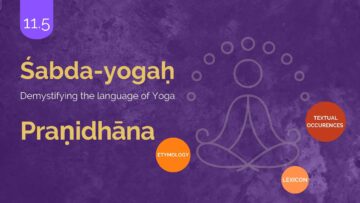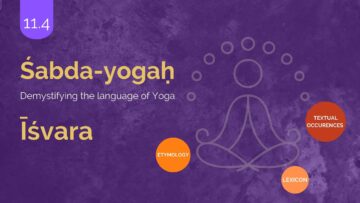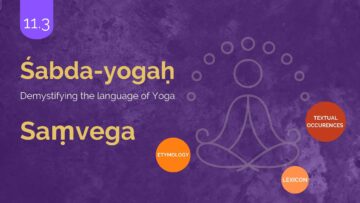Introduction
In this series, Yogic terminologies will be taken up and their –
- Etymological analysis,
- Lexical descriptions and
- Textual occurrences in Yogic literature and their commentaries, as available, will be presented. And finally observations will be made on the references.
Three texts – Yogasūtra, Haṭha-yoga-pradīpikā and Bhagavad-gītā are consulted for textual occurrences portion.
Śabda-yoga is intended to help students, teachers, and professionals of Yoga to develop a sound grammatical, contextual, and thereby an authentic and immersive understanding of Yoga terminologies.
7.4 Viṣaya
वि+सि+अच् = विषयः
vi+si+ac = viṣayaḥ
विVi is the prefix
The root is सि–si that means बन्धनम् -Bandhanam – to bind
The suffix is अच्ac. It is used in the meaning of the doer kartṛ. The suffix is added as per the grammatical rule – नन्दिग्रहिपचादिभ्योल्युणिन्यचःnandigrahipacādibhyolyuṇinyacaḥ (aṣṭādhyāyī 3. 1.134)
Based on the above etymology the derivative statement for the word is – विसिन्वन्तिइतिविषयाः – visinvantiitiviṣayāḥ – those that bind (objects of the senses)
Lexicon
There are four references to the term Viṣaya in Amarakośa. They are as follows.
रूपंशब्दोगन्धरसस्पर्शाश्चविषयाअमी1.5.7
rūpaṃśabdogandharasasparśāścaviṣayāamī 1.5.7
Form, sound, smell, taste and touch are the objects (Viṣayas of the senses)
…देशविषयौतूपवर्तनम्2.1.8
…deśaviṣayautūpavartanam 2.1.8
The words Upavartana, deśa and Viṣaya indicate a country.
… विषयआश्रये3.2.11
… viṣayaāśraye 3.2.11
The words Viṣaya and Āśraya are used to indicate substratum.
विषयोयस्ययोज्ञातस्तत्रशब्दादिकेष्वपि3.3.153
viṣayoyasyayojñātastatraśabdādikeṣvapi 3.3.153
Viṣaya is used to refer things that are known, objects of the senses etc (and country).
Looking into these references based on the lexicon four possible meanings could be noticed for the term Viṣaya a) objects of the senses b) Country c) substratum d) whatever things people know
Textual Occurrences
Yogasūtra
There are twelve references to this term Yogasūtras. This term is found in the first three chapters and not in the fourth. The major concentration of the usage of the term is found in the first chapter (8 occurrences). A chapter wise summary of the references is given below –
Chapter 1
The eight references from the first chapter are as follows –
अनुभूतविषयासंप्रमोषःस्मृतिः॥१.११॥
दृष्टानुश्रविकविषयवितृष्णस्यवशीकारसंज्ञावैराग्यम्॥१.१५॥
मैत्रीकरुणामुदितोपेक्षाणांसुखदुःखपुण्यापुण्यविषयाणांभावनातश्चितप्रसादनम्॥१.३३॥
विषयवतीवाप्रवृत्तिरुत्पन्नामनसःस्थितिनिबन्धनी॥१.३५॥
वीतरागविषयंवाचित्तम्॥१.३७॥
एतयैवसविचारानिर्विचाराचसूक्ष्मविषयाव्याख्याता॥१.४४॥
सूक्ष्मविषयत्वंचालिङ्गपर्यवसानम्॥१.४५॥
श्रुतानुमानप्रज्ञाभ्यामन्यविषयाविशेषार्थत्वात्॥१.४९॥
anubhūtaviṣayāsaṃpramoṣaḥsmṛtiḥ .. 1.11 ..
dṛṣṭānuśravikaviṣayavitṛṣṇasyavaśīkārasaṃjñāvairāgyam .. 1.15 ..
maitrīkaruṇāmuditopekṣāṇāṃsukhaduḥkhapuṇyāpuṇyaviṣayāṇāṃbhāvanātaścitaprasādanam .. 1.33 ..
viṣayavatīvāpravṛttirutpannāmanasaḥsthitinibandhanī .. 1.35 ..
vītarāgaviṣayaṃvācittam .. 1.37 ..
etayaivasavicārānirvicārā ca sūkṣmaviṣayāvyākhyātā .. 1.44 ..
sūkṣmaviṣayatvaṃcāliṅgaparyavasānam .. 1.45 ..
śrutānumānaprajñābhyāmanyaviṣayāviśeṣārthatvāt .. 1.49 ..
Summary: Sūtra 1.11 – Defines Smṛti (remembering) as not forgetting the Viṣaya (object) that has been experienced (through senses). Sūtra 1.15 – defines Vairāgya. Dispassion is not getting attached to Viṣayas (objects of pleasure) of this world and those that are described in scriptures (to be attained after the current life). Sūtra 1.33 discusses Maitrī and other Bhāvanas to attain Citta-prasādana (non-agītāted state of mind). There the word Viṣaya is used in the sense of object of experience. The expression sukhaduḥkhapuṇyāpuṇyaviṣaya is to be noted. This refers to people who have sukha, dukkha, puṇya and apuṇya as their Viṣaya/object of experience. Sūtra 1.35 describes ViṣayavatīPravṛtti which refers to divine sensory experiences generated by meditating upon the places of sense organs like tip of the tongue, tip of the nose etc. Here too Viṣaya refers to the objects of sensory experience. Sūtra 1.37 again mentions focusing the citta on a Viṣaya – object to attain Citta-prasadana. The object for the citta specified here is a saintly person who has overcome passion. In Sūtra 1.44 it is clarified that savicāra and nirvicārasamāpattis happen when the Citta is focused on a sūkṣma-subtle Viṣaya-object of focus. Sūtra 1.45 Continues on SūkṣmaViṣaya and states that the most subtle object for Samāpatti is the aliṅga or prakṛti. Sūtra 1.49 speaks about Viṣaya – object contained in the ṛtambharāprajñā. It is clarified that the object of ṛtambharā is neither derived from inference or from verbal testimony. It is experienced with direct yogic perception.
Chapter 2
There are two occurrences of the term Viṣaya in this chapter. They are as follows –
बाह्याभ्यन्तरविषयाक्षेपीचतुर्थः॥२.५१॥
स्वविषयासंप्रयोगेचितस्वरूपानुकारइवेन्द्रियाणांप्रत्याहारः॥२.५४॥
bāhyābhyantaraviṣayākṣepīcaturthaḥ .. 2.51 ..
svaviṣayāsaṃprayogecitasvarūpānukāraivendriyāṇāṃpratyāhāraḥ .. 2.54 ..
Summary: According to Yogasiddhāntacandrikā commentary the word Viṣaya in the sūtra 2.51 refers to Deśa or place. Earlier in sahitakumbhakas the place within the body and outside the body is important to understand the length to which the breath inhaled or exhaled is felt. In Kevalakumbhaka which is described as the fourth Prāṇāyāma the breath simply exceeds the places within and without and hence is all pervasive in this state. Similar to the limitlessness of the Deśa in this Kevalakumbhakaprāṇāyāma, Tattvavaiśāradī commentary clarifies that there is no limit to this Kevalakumbhakaprāṇāyāma in terms of Kāla (time) and Saṅkhyā (counts) also.
Sūtra 2.52 defines Pratyāhāra the fifth limb of Aṣṭāṅgayoga. Here the non-association of the senses with its Viṣayas (objects of the senses) &the senses following the form that the citta takes are described as aspects of definition of Pratyāhāra.
Chapter 3
There are two references to Viṣaya is this chapter. They are –
नचतत्सालम्बनंतस्याविषयीभूतत्वात्॥३.२०॥
तारकंसर्वविषयंसर्वथाविषयमक्रमंचेतिविवेकजंज्ञानम्॥३.५४॥
na ca tatsālambanaṃtasyāviṣayībhūtatvāt .. 3.20 ..
tārakaṃsarvaviṣayaṃsarvathāviṣayamakramaṃcetivivekajaṃjñānam .. 3.54 ..
Summary: Sūtra3.20 is a clarification about the Siddhi mentioned in the previous Sūtra. The previous sūtra mentions about the power of knowing other person’s mind (para-citta-jñāna). It is clarified in this sūtra (3.20) that the Siddhi mentioned in the previous Sūtra is limited only to knowing the state of the mind of others and the ālambana/the object that led such a state of mind of the person shall not be known by the Yogin. This is so because the object of Saṃyama (dhāraṇā-dhyāna-samādhi) to attain the siddhi did not include the ālambana (aviṣaya). Sūtra 3.20 speaks about the outcome of the practice of Saṃyama mentioned in 3.52 (saṃyama on the kṣaṇa– basic unit of time and its karma – its sequence). Vivekajñāna that encompasses all Viṣayas (objects) and all dimensions of those objects will manifest all at once because of this Saṃyama.
Bhagavadgītā
There are nine references in Bhagavadgītā on the usage of the term Viṣaya. In Chapters 2, 4, 15, 1 8 the expressions are found.
Chapter 2
There are four references in this chapter. They are –
त्रैगुण्यविषयावेदानिस्त्रैगुण्योभवार्जुन।
निर्द्वन्द्वोनित्यसत्त्वस्थोनिर्योगक्षेमआत्मवान्॥२.४५॥
विषयाविनिवर्तन्तेनिराहारस्यदेहिनः।
रसवर्जंरसोऽप्यस्यपरंदृष्ट्वानिवर्तते॥२.५९॥
ध्यायतोविषयान्पुंसःसङ्गस्तेषूपजायते।
सङ्गात्सञ्जायतेकामःकामात्क्रोधोऽभिजायते॥२.६२॥
रागद्वेषवियुक्तैस्तुविषयानिन्द्रियैश्चरन्।
आत्मवश्यैर्विधेयात्माप्रसादमधिगच्छति॥२.६४॥
traiguṇyaviṣayāvedānistraiguṇyobhavārjuna .
nirdvandvonityasattvasthoniryogakṣemaātmavān .. 2.45 ..
viṣayāvinivartantenirāhārasyadehinaḥ .
rasavarjaṃraso’pyasyaparaṃdṛṣṭvānivartate .. 2.59 ..
dhyāyatoviṣayānpuṃsaḥsaṅgasteṣūpajāyate .
saṅgātsañjāyatekāmaḥkāmātkrodho’bhijāyate .. 2.62 ..
rāgadveṣaviyuktaistuviṣayānindriyaiścaran .
ātmavaśyairvidheyātmāprasādamadhigacchati .. 2.64 ..
Summary: The expression traiguṇya-viṣayā is found in verse 2.45 where it is stated that the viṣayās- objects discussed in the Karmakāṇḍa portion of the Vedas are all focused on the three Guṇas – Sattva, Rajas and Tamas and one should transcend these. In the context of verse 2.59 it has been stated that viṣayās – the objects of the senses/ the attraction towards them will wade away when the senses are starved – by not allowing the connection that they want to make with their respective objects (as part of practice of sense control). Verse 2.62 mentions the consequences of Viṣaya-dhyana – thinking about the objects of the senses. Verse 2.64 advises – experiencing the objects of the senses without Rāga and Dveṣa for attainment of pleasant and stable state of mind.
Chapter 4
The solitary reference to viṣaya in this chapter is as follows –
श्रोत्रादीनीन्द्रियाण्यन्येसंयमाग्निषुजुह्वति।
शब्दादीन्विषयानन्यइन्द्रियाग्निषुजुह्वति॥४.२६॥
śrotrādīnīndriyāṇyanyesaṃyamāgniṣujuhvati .
śabdādīnviṣayānanyaindriyāgniṣujuhvati .. 4.26 ..
Summary: Various kinds of Yajñas are being described in this chapter. This verse mentions about yajñas connected with the senses and their Viṣayas –objects. The objects of the senses like sound etc (śabdādī-viṣaya) are the offerings and the fire into which they are offered are the senses themselves. śrī-śaṅkara-bhagavatpāda in his commentary to the verse clarifies that the experiencing of those Viṣayas (objects of the senses) that are non-distracting (in connection to the Samyagdarśana) also is considered by a few as Yajña.
Chapter 15
This chapter has two references. They are as follows –
अधश्चोर्ध्वंप्रसृतास्तस्यशाखागुणप्रवृद्धाविषयप्रवालाः।
अधश्चमूलान्यनुसन्ततानिकर्मानुबन्धीनिमनुष्यलोके॥१५.२॥
श्रोत्रंचक्षुःस्पर्शनंचरसनंघ्राणमेवच।
अधिष्ठायमनश्चायंविषयानुपसेवते॥१५.९॥
adhaścordhvaṃprasṛtāstasyaśākhāguṇapravṛddhāviṣayapravālāḥ .
adhaścamūlānyanusantatānikarmānubandhīnimanuṣyaloke .. 15.2 ..
śrotraṃcakṣuḥsparśanaṃ ca rasanaṃghrāṇameva ca .
adhiṣṭhāyamanaścāyaṃviṣayānupasevate .. 15.9 ..
Summary: Verse 15.2 is part of description of the entire creation as a tree. Here the Viṣayas/objects of the senses are described as young leaves/shoots. Verse 15.9 the individual soul being established in the manas and the senses experiences the respective Viṣayas-objects of the senses.
Chapter 18
There are a couple of references in this chapter to the word Viṣaya. They are as follows –
विषयेन्द्रियसंयोगाद्यत्तदग्रेऽमृतोपमम्।
परिणामेविषमिवतत्सुखंराजसंस्मृतम्॥१८.३८॥
बुद्ध्याविशुद्धयायुक्तोधृत्यात्मानंनियम्यच।
शब्दादीन्विषयांस्त्यक्त्वारागद्वेषौव्युदस्यच॥१८.५१॥
viṣayendriyasaṃyogādyattadagre’mṛtopamam .
pariṇāmeviṣamivatatsukhaṃrājasaṃsmṛtam .. 18.38 ..
buddhyāviśuddhayāyuktodhṛtyātmānaṃniyamya ca .
śabdādīnviṣayāṃstyaktvārāgadveṣauvyudasya ca .. 18.51 ..
Summary: In the both verses 18.38 & 18.51 Viṣaya refers to the objects of the senses. In the former reference rājasikasukha is described as that where initially due to sense object contact pleasure is experienced and later as consequence of that contact one suffers. In the second reference the way to attain highest knowledge (realization of consciousness) is described. Among the methods to attain highest knowledge (jñānasyaparākāṣṭhā – śrīśāṅkarabhāṣyam), the need to renounce the Viṣaya – objects of the sense such as sound etc is advised.
Haṭhayogapradīpikā
This text has five occurrences of the term Viṣaya. It is interesting to note that all the references are from the last chapter of the text. The references are as follows –
दुर्लभोविषयत्यागोदुर्लभंतत्त्वदर्शनम्।
दुर्लभासहजावस्थासद्गुरोःकरुणांविना॥४.९॥
प्रणष्टश्वासनिश्वासःप्रध्वस्तविषयग्रहः।
निष्चेष्टोनिर्विकारश्चलयोजयतियोगिनाम्॥४.३१॥
लयोलयइतिप्राहुःकीदृशंलयलक्षणम्।
अपुनर्वासनोत्थानात्लयोविषयविस्मृतिः॥४.३४॥
मकरन्दंपिबन्भृङ्गोगन्धंनापेक्षतेयथा।
नादासक्तंतथाचित्तंविषयान्नहिकाङ्क्षते॥४.९०॥
मनोमत्तगजेन्द्रस्यविषयोद्यानचारिणः।
समर्थोऽयंनियमनेनिनादनिशिताङ्कुश॥४.९१॥
durlabhoviṣayatyāgodurlabhaṃtattvadarśanam .
durlabhāsahajāvasthāsadguroḥkaruṇāṃvinā .. 4.9 ..
praṇaṣṭaśvāsaniśvāsaḥpradhvastaviṣayagrahaḥ .
niṣceṣṭonirvikāraścalayojayatiyoginām .. 4.31 ..
layolayaitiprāhuḥkīdṛśaṃlayalakṣaṇam .
apunarvāsanotthānātlayoviṣayavismṛtiḥ .. 4.34 ..
makarandaṃpibanbhṛṅgogandhaṃnāpekṣateyathā .
nādāsaktaṃtathācittaṃviṣayānna hi kāṅkṣate .. 4.90 ..
manomattagajendrasyaviṣayodyānacāriṇaḥ .
samartho’yaṃniyamaneninādaniśitāṅkuśa .. 4.91 ..
Summary: Viṣayatyāga – renouncing the objects of the senses is described in 4.9. Towards this, it is mentioned here that grace of the Guru is required. In verse 4.31 the greatness of the state of Laya (absorption of the mind) is described where there will be no desire to connect with the Viṣayas – object of the senses (hence there will be no distraction or suffering due to that). The same idea as that of 4.31 is described in 4.34 where in the state of Laya – due to non-arousal of the vāsanas, the Viṣayas- objects of the senses are forgotten. Both verses 4.90 and 4.91 – describe the greatness of Nādānusandhāna that attracts the mind more than the attractions of the Viṣayas – objects of the senses.
Tabulation of Textual References
1) From the numerous references from the three Yoga works on the word Viṣaya, its importance can be understood in the yogic context.
2) As could be observed, most of the references are focused on the objects of the senses. It becomes evident that – the control of the senses with regard to experiencing the respective Viṣaya is of paramount importance in all the three streams of Yoga represented by the three texts.
3) Even the very high aspects like Nādānusandhāna in hathayoga, Yajña in the Gītā, are all concerned with the control of the senses.
4) It is interesting to note the two fold classification the sthūla and sūkṣmaViṣaya is presented in in the context of discussing the object for Samādhi is described in Yogasūtras.
5) Rarely in the Yogasūtra the word Viṣaya is used to indicate the meaning Deśa – place.
These are the observations on the usage of the term Viṣaya in the context of Yoga.
References
- Advaitaśāradā – https://advaitasharada.sringeri.net/
- Amarakoṣasampat – http://amara.aupasana.com/
- Aṣṭādhyāyī – https://ashtadhyayi.com/
- Aksharamukha – https://aksharamukha.appspot.com/
- Avyayakośaḥ, śrīśrīvatsāṅkācāryaḥ, saṃskṛtavidyāsamitiḥ, chennai, 2004
- Gītā Supersite – https://www.Gītāsupersite.iitk.ac.in/
- Nāmaliṅgānuśāsana alias amarakoṣa of amarasiṃha with the commentary vyākhyāsudhā or rāmāśramī by bhānujidīkṣita, Edited with notes by M.M.PanditShivadattaDadimatha, ChaukhambaSaṃskṛtaPrathisthan, Delhi, Reprint 2002
- śabdārthakaustubha, cakravartīśrīnivāsagopālācārya, Vol 4, Bappco Publication, Bengaluru, Reprint 2009
- Yoga-vaiśāradī – https://kymyogavaisharadi.org/
Unit 7 To be Continued…
Links for previous posts in this unit
Disclaimer: The opinions expressed in this article belong to the author. Indic Today is neither responsible nor liable for the accuracy, completeness, suitability, or validity of any information in the article.

